Photos with this report (click to enlarge) | |||
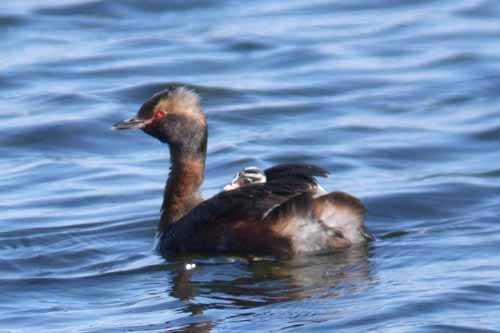 Slavonian Grebe |
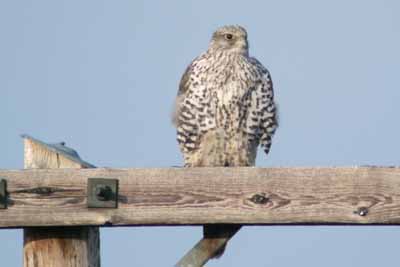 Gyrfalcon |
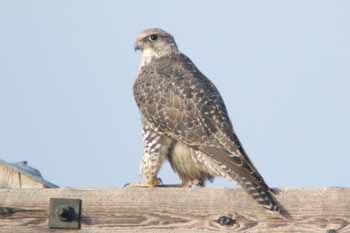 Gyrfalcon |
|
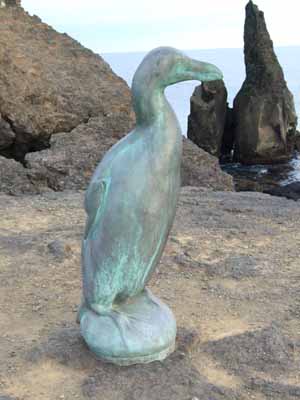 Great Auk |
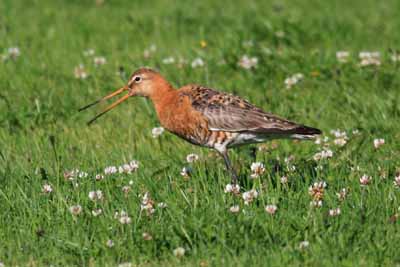 Black-tailed Godwit |
||
Introduction
This short trip report outlines a visit to Iceland, made in early August 2011. With a birder to civilian ratio of 1 to 2, this trip was far from hardcore birding and, in fact, we spent most of our time moving from place to place and doing tourist things such as visiting glaciers and waterfalls (loads of these!), taking photographs, sitting in hot springs (including one formed from power station run-off; makes a change from creeping round the edges scoping such pools for waders!), whale-watching, botanising, horse-riding (not me…), stopping for a look or a walk anywhere that took our fancy and generally going ‘wow’ at the amazing, perpetual eye candy that Iceland is. Even so, by not sleeping very much and making sure we had a longer (two night) stopover at what was far and away the best area in Iceland for breeding birds (Myvatn), I found it perfectly possible to locate and indulge in almost all of Iceland’s summer birds on this week-long trip. Only two key species were missed; White-tailed Sea-Eagle (because we didn’t visit their stronghold in the north-western fjords) and Brünnich’s Guillemot (too late in the season). But in the grand scheme of things, that was incidental.
Timing
In some ways, early August is a little past peak time for birding in Iceland. Most waders have stopped singing and displaying, all ducks are in grubby eclipse and many auks (although not Puffins) have left their colonies; don’t come at this time of year if you cannot live without Brünnich’s Guillemot! However, on the positive side, all waders are still present (and easy to find), seeing chicks and families of species such as Whooper Swans, Slavonian Grebes, divers and phalaropes is awesome and something that you won’t manage in June and, just maybe, Gyrfalcons are more widespread as they are no longer pinned down to their eyries, and dispersing juveniles become more obvious. Blue Whale is apparently more likely in June – but they are erratic and unpredictable anyway - but the flora is, I guess, at its best when we went. We went in early August because a June or July trip was not feasible for us but, to be honest, Iceland is so dramatic and full of nature that anytime is likely to be very rewarding. As long as you get the weather! (See below.)
Costs
This is traditionally a big consideration when planning a trip to Iceland and puts many people off, although, at least if you are coming from the UK, differences are greatly exaggerated (assuming you can do without beer for a week). With the Icelandic Kroner fluctuating at between 170-180 IKr to the pound, the total cost for the basics for our trip was £850 per person for seven days. This included flights from Manchester to Keflavik with IcelandAir (www.icelandair.com) (with a bonus stopover in Glasgow en-route for no extra price! Great!), all accommodation and car hire (see below), grub to cook each night (bought in a supermarket in Rekjavik on arrival, and then each day as needed in shops en-route) and petrol (actually a little cheaper per litre than in the UK!). It does not include any extras such as glacier walks, whale watching in Husavik (actually quite good value: 54 Euros for 3 hours), booze (stock up in the airport at Manchester!), or visits to thermal springs (try those at Myvatn; the Blue Lagoon near Keflavik is a total tourist trap at 28 Euros entry).
Accommodation and car hire
This was all bought as a package from the Icelandic Youth Hostel organization (www.hostel.ie). We paid approximately £1200 in total (between three people) for seven nights accommodation in ‘family rooms’ (usually 3 or 4 single beds, sometimes bunks in a fairly basic, simple room) and car rental (having shopped around, this bit is really expensive; anything less than about £750-800 per week in high summer is a really good deal). Booking everything was dead easy; it was all done online in about two emails – the folks in the office are super-efficient and helpful (like everyone we met in Iceland). It is worth booking accommodation as far in advance as possible; we sorted ours in late April and even then we did not get our first choices in two locations. However, everywhere we did stay was great: clean, well-organised, fantastic hot showers, good cooking facilities, lots of friendly people and spectacular locations, generally with epic birding virtually on the doorstep. Kept out by the weather and gorgeous evening light, and doing things en-route, we generally rolled up each night at between 2100-2200 but we were always expected and welcomed. All hostels (and everything else) were easily found; there are signposts everywhere and a decent map came with the package.
Weather
This is the make or break bit. Apparently Iceland averages 154 hours of sunlight for the whole of August; by sleeping on average for 5 hours a night I reckon I totaled about 120 of those in just one week. We were incredibly lucky; people we met in the hostel on the first night had suffered horizontal rain for days just before we arrived, and Atlantic lows pounced a day or so after we left. But whilst we there, the weather was unbelievable: amazing visibility, beautiful fresh air, little or no wind and very limited cloud. It did rain, but that comprised the merest dusting (20 seconds) on the last night. If you get weather like this, it’s a slam dunk in Iceland at any time of year. But it’s a big if!
Route
In an effort to see as much of the country as possible, and having to decide the route in a bit of rush after we suddenly got a good price for flights and realized that accommodation was filling up fast, we opted to do the entire ring road (850 miles). This meant a lot of driving and, initially, we were thinking we had bitten off more that we could comfortably chew in a week. To really soak the place up and maybe divert into the north-west for a bit, ten days to two weeks would be optimum. However, we didn’t have that sort of time and, as it turned out, on most days we felt we had enough time to see everything we wanted and get to where we needed to be by a not too unreasonable time each evening. Awesome weather really helped, as did the wonderful long evenings (barely dark by 2230). We had one night at each hostel, save for two nights at Arbot, near Myvatn (this was a good choice; indeed near essential if you want to really savor this fantastic place; one night only there would have meant we missed out whale-watching or really hammering the lake and its Gyrfalcons). We made a lot of stops en-route, by using the guidebook or anytime we came across a tern colony or waterfall that needed a photograph, or anything that vaguely resembled a perched Gyr. Driving is easy; the roads are empty and in good condition; it is perfectly feasible to sit at 80-90 kph when you need to move (90 kph is the speed limit and it appears to be enforced with typical Scandinavian efficiency).
Getting out of Keflavik airport by 1700, we effectively did the ring-road in a counter-clockwise direction (south coast first). The hostels we stayed in, and a few relevant comments about each, are detailed below:
1. Laugarvatn (1 night). Not much more than one hour from Rekjavik and to the east-north-east, but factor in time for a stop and walk at the dramatic Pingvallavatn en-route. The hostel is right on the shore of a nice, birdy lake, with Redwings and Black-wits on the lawns and has some reasonable ‘forest’ (by Icelandic standards!) up the hill behind the village.
2. Skogal (1 night; south coast). About 2-3 hours from Geysir and Gulfloss, sites that we visited in the morning. The former is about 30 minutes from Laugarvatn. It’s a fine drive getting to Skogal; we went down to the Heimay ferry to get a view over Vestmannaeyjar islands; Hekla and Seljarlandsfoss waterfall are unmissable. From Skogal you can get up into the hills very easily by hiking up past the waterfall just behind the hostel. There was a reasonable estuary for waders a few km back along the road to the west and I had my first Harlequin of the trip on the river by the hostel.
3. Berunes (1 night; east coast). It took us about 10 hours to get here from Skogal, but we did have long stops at the seabird cliffs of Dryholaey and fabulous iceberg-cluttered lake of Jokulsalon, plus a few shorter ones elsewhere. It was probably about 5-6 hours driving in all. Berunes was one of the nicest hostels we stayed in and, as well as good birding in the fjord, we also found some excellent alpines on the lush, ungrazed ledges by the small waterfall behind the hostel.
4. Arbot (2 nights; north east). We had a late departure from Berunes, and spent most of the day getting here, as we had a long walk and look at Dettifoss en-route, plus a short recce of Myvatn on the way past. Arbot is another splendid hostel in a spectacular location, but note that it is about 40-45 mins from Myvatn and hence not ideally situated for conveniently visiting the lake. However, Barrow’s Goldeneye on the River Laxa, visible by a short walk from the front door helps to ameliorate this. The other Icelandic Youth Hostel location in the general area, Berg, is not any closer to Myvatn.
5. Seaborg (1 night). Again we got here late, after a 1400 departure from Husavik and a rather long (c70 km) but spectacular and very worthwhile detour looping round the Vatnsnes peninsula. Next morning I spent an hour scoping the fjord from the garden and racked up a very respectable 20 species including six Glaucous Gulls, 4 Great Northern Divers and 2 Gyrs, one of spent the entire period perched on the Puffin islands a km or so further north.
6. Keflavik (1 night). This hostel, actually in Njardvik, is 45 mins from Rekjavik and about 5 minutes from the airport; we stayed here as we had an early flight out next morning. The setting, on an industrial estate on the edge of bay was rather less splendid than anywhere else and it was also much harder to find than any of other hostels; this may be one place where it really is worth while having decent directions for. Inside, the hostel itself was fine, and no more than 15 minutes from the Blue Lagoon.
Notes on selected species and sites, additional to those associated with the hostels (for which, see above)
Birds are everywhere in Iceland and most are very easy to find. We racked up 62 species in all; below I have briefly given details of where we got to grips with some of the more interesting ones. I have also woven in some information on some of the most productive sites.
• Breeding divers: Fairly thinly scattered, especially Great Northern (mainly on the sea; you need to visit Myvatn to see them at their best).
• Slavonian Grebe: Only at Myvatn, where easy.
• Whooper Swan: Everywhere but it is worth mentioning Lonsfjordur, an amazing coastal lagoon a bit north of Hofn in south east Iceland. We had no idea it was coming up and were worried about getting to Berunes on time, so had only a very short look here. This was a shame as it was covered in thousands of moulting Whoopers and hence a really quite awe-inspiring sight.
• Pink-footed Goose: We logged a few in the Myvatn area but to see them in their classic breeding habitat you need to visit the barren, wind-blasted tundra between Egillstadir and Dettifloss in the north east of the island. We found a number of families from the roadside here.
• Pochard: I only mention this in case any Icelandic birders are reading this. A male on Myvatn from the #848, with Eurasian Coot nearby!
• Barrow’s Goldeneye: Only Myvatn, but abundant here. I reckoned about 1000 in all; views are much better on the Laxa than on the main lake. A few males were still pretty much in breeding plumage.
• Harlequin: First was point-blank on the river outside Skogal hostel but best seen on the Laxa River at Myvatn; very easy from the bridge.
• Merlin: Surprisingly widespread; seen most days.
• Gyrfalcon: In the end, we racked up 5 sightings (of 4 individuals) of this spectacular Arctic talisman. All were in the north between Myvatn and Seaborg. One individual at the former was by far the best (see Myvatn, below) but we also fell in with them on Vatnsnes Peninsula (half way down the west side) and even from the garden at Seaborg hostel (see above).
• Ptarmigan: A family in the lush willow tundra off the #848. Keeping a very low profile, and wisely so; there was a Gyr on the wires only a few hundred metres back! Not seen anywhere else.
• Red-necked Phalarope: This species seemed to have finished breeding by early August; I saw rather low numbers, all in the north and including a few from the boat out of Husavik. One taking midges on the track by a small bay at Myvatn almost ran through my legs.
• Glaucous Gull: Small numbers widespread on the north-facing coasts. Best seen in Husavik, where it was possible to compare the real thing with several blatant Glaucous x Herring hybrids.
• Breeding seabirds: These were less numerous than I expected, save for Puffins which still thronged in enormous numbers at several locations. Dryholaey, despite being a bit of a bumpy detour off the road west of Vik is well worth visiting for spectacular coastal scenery and gave us the best selection of breeding seabirds of the week. These included Bonxies, actually quite localized in Iceland and scarce away from the south-east; Arctic Skuas are rather more widespread and easily found hunting the fields and moorlands between Myvatn and Arbot. After visiting Reykjanesta (see following paragraph), I stomped out to at Hafnaberg cliffs, a known site for Brünnich’s Guillemot. However, the population here is down to about 10 pairs and 12th August was well too late for this rare auk, or, indeed, any other auks. However, this was the only site I saw Shag and Manx Shearwater. Note that the rolling moorland is deceptive here; the cliffs are a good half-hour walk from the road. En-route you can get tremendous abuse from the local Whimbrel clan.
• Great Auk: The closet thing you will get to ever experiencing this forlorn ghost of the past is to make a visit to the Reykjanesta headland on the south west tip of Iceland form which you can look onto Eldey, the massive slab of offshore rock where the last known Garrefowl was killed in 1844. A metal statue some six feet tall has been erected and oriented so that he gazes mournfully out over Eldey, making for a far more original, poignant and profound experience than you’ll get at the Blue Lagoon, 20 minutes back up the road. Well worth a visit even without the Orca’s offshore.
• Short-eared Owl: Only seen once, hunting at dusk near the Laxa, Myvatn.
• Snow Bunting: Not common; only two seen: a male feeding a juvenile in the carpark at Jakulsalon. This was one of only 9 species of passerines, but Redwings feeding spotty juveniles everywhere and wily Rekjavik Ravens on the lawns of parks made up for that. I thought I was hearing calling Goldcrests on Laugarvatn on the first morning but discounted that on the basis of that species not occurring in Iceland. Not true! I later learnt that it colonized in 1996.
• Myvatn: Being the summer home for many of the birds in Ireland that I grew up with, I really wanted to visit this place. It didn’t disappoint; this is the birdiest location in Iceland, and is set amongst some of the most spectacular and surreal landscape in the country. Which, of course, means it is amidst some the most spectacular landscape on the planet. There are loads of things here for civilians to do as well, so it should be possible to get some peace to soak up the birds. The best tactic here is to get onto the highway #848 that runs south down the west side of the lake and leads eventually to the Laxa river bridge. This is 9-10 km walk from the Myvatn to Husavik road; I did it from 1500 to 2230 one night and then went back again ‘til 0900 next morning, picking out the best bits by car. It is all really good, and the road winds right by many of the small bays of the lake, so views are sensational. In particular, try the gravel road running east from the #848 just north of the first close bay (only a km or two from the Husavik road; there is a large sign for a Goldeneye restaurant or viewpoint); this gets you right into the tundra pools, several of which had breeding divers (both species) and the pylons in this immediate area produced Gyrfalcon twice, once at 2100 and then again at 0600, 33 hours later. The second time, it was really approachable and allowed stupendous views down to 50 metres. Another essential stop is to make it to the famed Laxa bridge; Harlequin’s were easy here and attacking the rapids in classic Torrent Duck style.
• Husavik: As well as whales (see below), this stunning Icelandic village has plenty of bird interest. The Laxa and associated lake about 10 km south of town have a good selection of waterbirds and there is a great beach walk starting about 5 km north of town that leads to a headland looking out onto the inevitably named Lundey Island with its black plague of Puffins.
• Vatnsnes Peninsula: It was only at the last minute that we decided to take a detour on the #711 through Osar and round this spectacular peninsula. It is only spectacular when you arrive; from a map it looks completely inconsequential. We stopped for a couple of nice walks, got socked in patches of sea fret swirling in and found lots of Whimbrels and several Glaucous Gulls. Better still was coming upon an amazing Arctic Tern colony on the west coast, not long before hitting the tar again. This proved a photographers dream with flying and perching adults everywhere; juveniles were actually landing on the track. A perched Gyr a little earlier certainly didn’t harm the general ambience either.
• Whale-watching: Husavik is the original home of whale-watching in Iceland. The latter is a massive industry; there were well over 100 people on the boat we went out on, and, at peak season (mid July – mid August) there may be upwards of a dozen boats per day. Whales (alive) must be a massive money-spinner in Iceland and this makes it all the more bizarre that their imbecilic government have caved into minority vested interests and allowed the resumption of commercial whaling. Helped by sensational scenery and a complete comedian as cruise ‘animateur’ on the ship’s loudspeaker, we had a very nice, although chilly, trip and eventually saw Minkes very well plus a Humpback at very close range, with Harbour Porpoise and White-beaked Dolphin thrown in for good measure. Apart from Common Seals at Osar, Vatnsnes, the only other mammals we recorded were a jammy sighting of a pod of Orcas, passing east between Rekjanesta and Eldey. There is apparently a frequently sighted pod in the Greater Rekjavik / Keflavik area; the headland north of Keflavik is another place worth trying for them.
If you require any further information on an anything contained in this report, please do not hesitate to contact the author at ojcampbell25 @ yahoo.com (omit spaces if emailing).